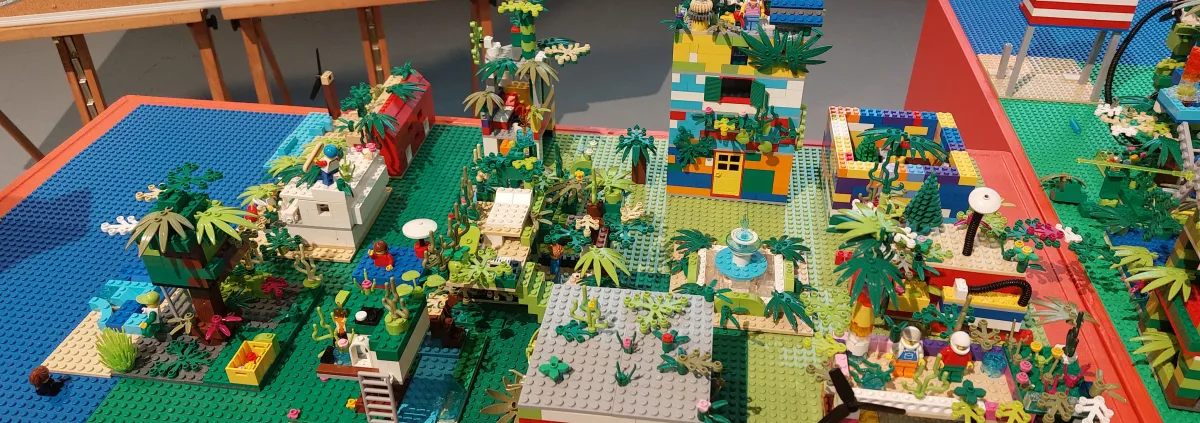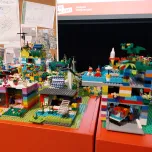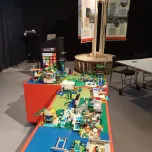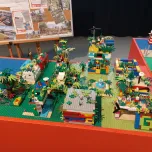Our Green Education Action focuses on empowering younger generations through science-driven, hopeful climate education. In close collaboration with different stakeholders: museum educators, scientists, and local governments, we aimed to inspire and engage children in envisioning and designing the nature-inclusive and climate-positive cities of the future. The activity is not just about educating young people on climate change; it’s about creating a sense of hope and agency, allowing them to see themselves as contributors to a sustainable future.
Young and doomed?
In today’s world, young people are constantly bombarded with news about the devastating impacts of climate change. It’s easy to feel overwhelmed, anxious, and helpless. Many wonder if their future is doomed, questioning the purpose of working hard if all that awaits is a world in chaos. Sadly, this is the reality for many young people across Europe.
But this narrative of doom is in stark contrast to the optimism within the climate adaptation science community. As scientists, we are developing nature-based solutions that can pave the way for a sustainable future. At Wageningen University & Research, we’ve consolidated these ideas under the NL2120 initiative (Nederland in 2120 - WUR), envisioning the Netherlands as a nature-inclusive, climate-positive society by the year 2120, prioritizing nature, a circular economy, quality of life, and safety.
Empowering hope and action
Recognizing the urgent need to reach out to young people, we launched the Green Education Initiative to show them that their future isn’t doomed. It’s essential to foster optimism and encourage proactive engagement in environmental stewardship. As scientists, it’s our responsibility to uplift the younger generations and to provide them with access to knowledge on climate solutions, rather than just focusing on the grim impacts.
That’s why we, scientists from Wageningen University & Research, teamed up with Museon-Omniversum, a museum in The Hague focused on sustainability, and with local governments to create a series of hopeful, science-driven climate education activities for children aged 6 to 14. This initiative is not just about teaching climate science; it’s about instilling hope and helping young people see themselves as active contributors to a sustainable future.
Building tomorrow's Green and Blue, with LEGO blocks and dreams come true!
During the Christmas holidays in 2023, 200 children visiting the Museon participated in a workshop to design their own green and blue city of the future—using LEGO. Spread across eight workshops, each session hosted a maximum of 25 children, many accompanied by parents who joined in or watched as their children’s excitement unfolded.
The workshops began with a presentation on the NL2120 vision, showcasing examples of “green and blue solutions” already in place. This introduction inspired the children and offered a glimpse into how we can thrive amid climate change.
Using LEGO as a medium, we empowered young participants to imagine and build their vision of a green and blue city. The atmosphere was creative and relaxed, with facilitators and scientists engaging in one-on-one discussions, sparking further ideas. The children created a diverse range of designs, including greenhouses with rooftop food production, solar-powered amphibious vehicles, and green playgrounds.
As the workshop concluded, all individual creations were assembled to form a unified city. All of us, children, parents, educators and scientists, gathered around this model city, discussing its various elements and their functions. The children were encouraged to think about why they would want to live in such a city, with responses ranging from a love of green spaces to the joy of seeing food grow locally. The final question of each session was whether the participants would like to see their city become a reality in the future. Enthusiastically, every child—and their parents—raised their hands.
At the end of each workshop, all individual creations were assembled into a unified city. Children, parents, educators, and scientists gathered around to discuss the city’s elements and their functions and why they love these elements. The children were asked if they would like to see their city become a reality, and every hand – and their parents’ hands too - enthusiastically shot up.
The impact: conversations, collaboration and hope
- Sparking conversations and opening eyes: The workshop was not just about building a city, but about the meaningful conversations during the process. As the children assembled their LEGO creations, they engaged in discussions about what they liked and why they would love to see these elements in their future city. This play-based approach allowed them to articulate their hopes and dreams for a sustainable future, making the idea of a climate-positive world feel achievable and think on individual initiatives.
- A collaborative vision: Impactful was also the feedback and interaction from scientists, peers, and parents. These conversations brought a sense of realism and credibility to the children's visions, reinforcing the idea that their ideas are not only valid but also aligned with expert thinking, and therefore made the bridge between education and science.
- Multi-generational outreach: Moreover, the collaborative nature of the workshops, wherein children worked alongside their parents and engaged with scientists, created a multi-generational dialogue about their future, ensuring that the lessons learned extend beyond the classroom and into the wider community. This intergenerational engagement is crucial, as it fosters a shared sense of responsibility for creating a sustainable future.
- Senses of pride and hope: The workshop concluded with a sense of collective pride about what they had accomplished together. Their collective effort underscored a powerful message: by working together, they can make a difference. Although not measured, we observed that the children left empowered, believing that a bright future is not only possible but also within their power to create. It raises awareness about the solutions they can organize for themselves. By presenting a hopeful narrative, we countered the overwhelming narrative of climate doom.
Through initiatives like this, we are showing the next generation—and their parents—that the green and blue future is something we can shape together, one brick at a time.
For more information: Kennisregio aan Zee





Please log in or sign up to comment.